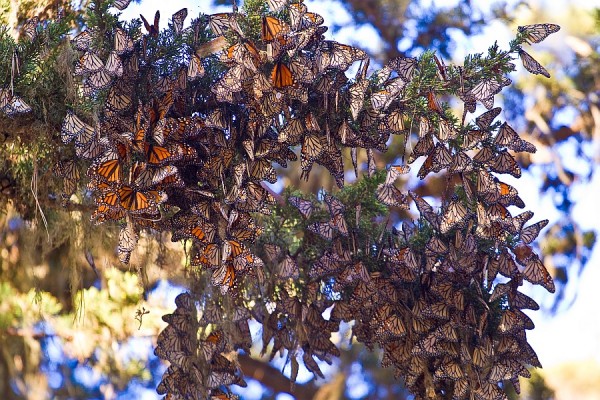Early Monarch Butterfly Migration this Fall Could Herald Population Increase
| Ana Verayo | | Sep 24, 2014 09:15 AM EDT |
(Photo : Agunther/Wikipedia) Migratory monarch butterflies seen in Pacific Grove, California
Experts believe the premature presence of monarch butterflies this early in the fall could be a sign its dwindling populations are finally increasing.
The first butterflies were seen approaching Mexico earlier than the usual time of year, said Luis Feyo, head of Mexico's nature reserves, He believes this is a sign of the butterflies' increasing populations as they migrate.
Like Us on Facebook
The first butterflies were sighted in Cohuilia near the U.S. border. The rest of the butterfly population usually arrives in October from the U.S. and Canada where they spend the summer.
In November, the butterflies will finally settle in the mountain forests where they will spend winter, which usually takes place in December.
Unfortunately, the past three years have seen a steady decline in monarch butterfly numbers. Fortunately, Mexico, the U.S. and Canada have already formed conservation groups in an effort to save this species.
In 2013, the butterflies only covered 1.65 acres of pine and fir forests located in the west of Mexico City compared to the 44.5 acres in 1996, the highest ever recorded peak.
Monarch butterfly populations are measured by how many acres of forest they cover during migration since it's an impossible feat to count them one by one.
According to Enrique Lando, head for international affairs of Mexico's Environment Department, a solid plan of action that will help conserve the butterflies will be implemented among the three nations by the end of November.
The plan will consist of creating milkweed-rich areas that will run along the path of the migratory route. This is pivotal for the monarch butterflies' survival because they need to reproduce during the migration so the next generation can finish the entire journey.
Monarchs lay their eggs on milkweed leaves but the decline in milkweed numbers is mainly caused by the widespread planting of genetically modified crops that hinders the growth of milkweed plants.
Mexico has already planted a number of milkweed patches along the migratory route. The existence of climate change and illegal logging along with the decline of habitats in North America, however, have made it difficult for the monarch butterfly to survive its perilous journey.
TagsEarly Monarch Butterfly Migration this Fall in U.S. and Mexico; Experts Predict Population Increase, Monarch butterfly, butterflies, monarch butterfly migration, mexico monarch butterflies US, mexico butterflies
©2015 Chinatopix All rights reserved. Do not reproduce without permission
EDITOR'S PICKS
-

Did the Trump administration just announce plans for a trade war with ‘hostile’ China and Russia?
-

US Senate passes Taiwan travel bill slammed by China
-

As Yan Sihong’s family grieves, here are other Chinese students who went missing abroad. Some have never been found
-

Beijing blasts Western critics who ‘smear China’ with the term sharp power
-

China Envoy Seeks to Defuse Tensions With U.S. as a Trade War Brews
-

Singapore's Deputy PM Provides Bitcoin Vote of Confidence Amid China's Blanket Bans
-

China warns investors over risks in overseas virtual currency trading
-

Chinese government most trustworthy: survey
-

Kashima Antlers On Course For Back-To-Back Titles
MOST POPULAR
LATEST NEWS
Zhou Yongkang: China's Former Security Chief Sentenced to Life in Prison

China's former Chief of the Ministry of Public Security, Zhou Yongkang, has been given a life sentence after he was found guilty of abusing his office, bribery and deliberately ... Full Article
TRENDING STORY

China Pork Prices Expected to Stabilize As The Supplies Recover

Elephone P9000 Smartphone is now on Sale on Amazon India

There's a Big Chance Cliffhangers Won't Still Be Resolved When Grey's Anatomy Season 13 Returns

Supreme Court Ruled on Samsung vs Apple Dispute for Patent Infringement

Microsoft Surface Pro 5 Rumors and Release Date: What is the Latest?










